Comprehensive Report: Operational Plan, Strategies, and Compliance
VerifiedAdded on 2023/01/12
|13
|4112
|93
Report
AI Summary
This report provides a detailed analysis of operational plans, covering various aspects crucial for business management and efficiency. It explores the relationship between strategic and operational plans, emphasizing the importance of clear goals and objectives. The report delves into resource management, including the types of resources needed, the role of consultation in the planning process, and strategies to ensure resource availability. It also examines key performance indicators (KPIs) and the implementation of quality monitoring systems to assess and improve business operations. Furthermore, the report discusses contingency planning, the steps for proposing resource requirements, and the role of organizational policies in recruitment, selection, and induction. Additional topics include staff consultation methods, the role of budget variations, and the importance of coaching and mentoring for employee development. The report also covers negotiation styles and essential documentation for recording processes. The assignment also includes a separate section on legal information sources related to workplace regulations, specifically focusing on licensing laws in the hospitality, travel, and tourism industries.
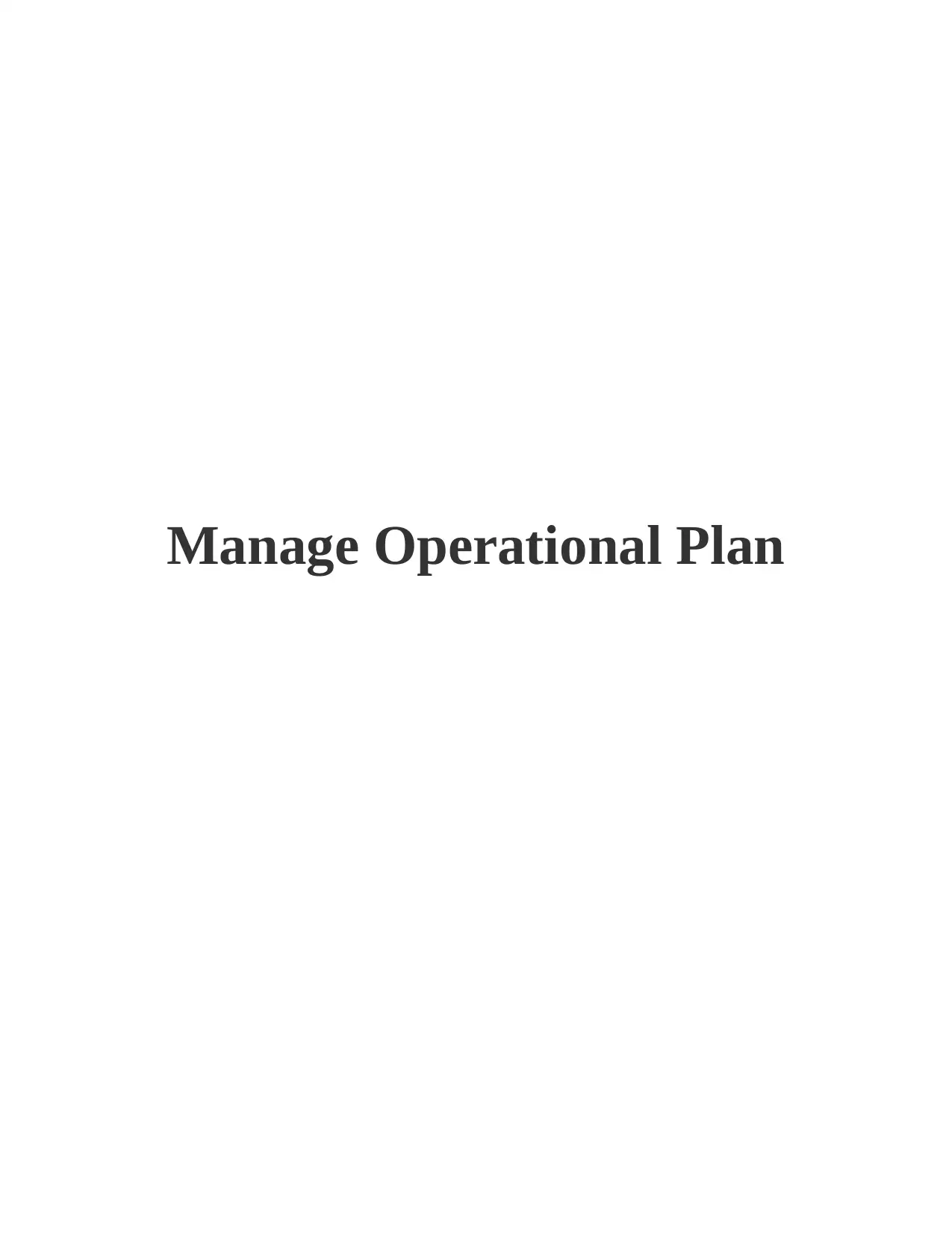
Manage Operational Plan
Paraphrase This Document
Need a fresh take? Get an instant paraphrase of this document with our AI Paraphraser
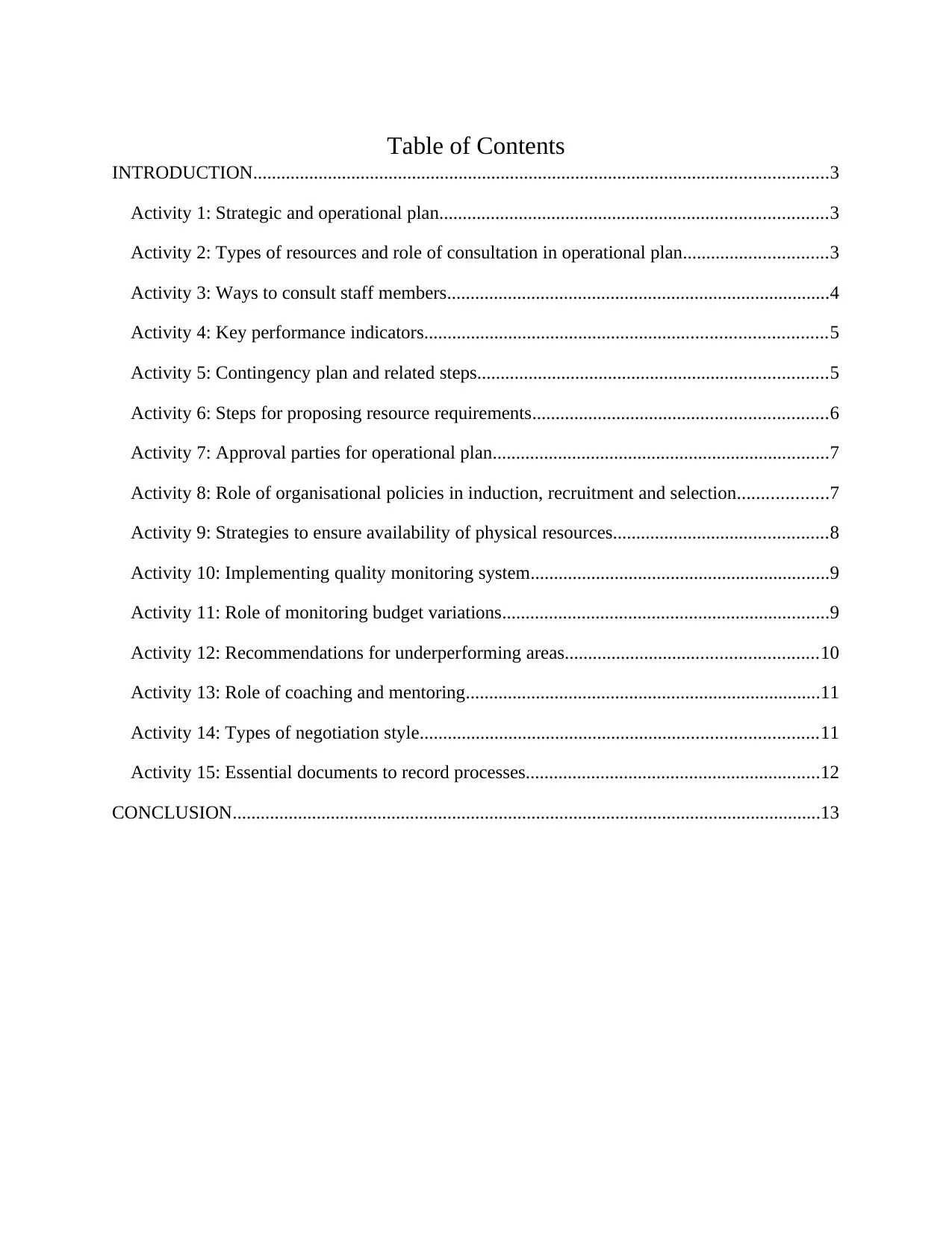
Table of Contents
INTRODUCTION...........................................................................................................................3
Activity 1: Strategic and operational plan...................................................................................3
Activity 2: Types of resources and role of consultation in operational plan...............................3
Activity 3: Ways to consult staff members..................................................................................4
Activity 4: Key performance indicators......................................................................................5
Activity 5: Contingency plan and related steps...........................................................................5
Activity 6: Steps for proposing resource requirements...............................................................6
Activity 7: Approval parties for operational plan........................................................................7
Activity 8: Role of organisational policies in induction, recruitment and selection...................7
Activity 9: Strategies to ensure availability of physical resources..............................................8
Activity 10: Implementing quality monitoring system................................................................9
Activity 11: Role of monitoring budget variations......................................................................9
Activity 12: Recommendations for underperforming areas......................................................10
Activity 13: Role of coaching and mentoring............................................................................11
Activity 14: Types of negotiation style.....................................................................................11
Activity 15: Essential documents to record processes...............................................................12
CONCLUSION..............................................................................................................................13
INTRODUCTION...........................................................................................................................3
Activity 1: Strategic and operational plan...................................................................................3
Activity 2: Types of resources and role of consultation in operational plan...............................3
Activity 3: Ways to consult staff members..................................................................................4
Activity 4: Key performance indicators......................................................................................5
Activity 5: Contingency plan and related steps...........................................................................5
Activity 6: Steps for proposing resource requirements...............................................................6
Activity 7: Approval parties for operational plan........................................................................7
Activity 8: Role of organisational policies in induction, recruitment and selection...................7
Activity 9: Strategies to ensure availability of physical resources..............................................8
Activity 10: Implementing quality monitoring system................................................................9
Activity 11: Role of monitoring budget variations......................................................................9
Activity 12: Recommendations for underperforming areas......................................................10
Activity 13: Role of coaching and mentoring............................................................................11
Activity 14: Types of negotiation style.....................................................................................11
Activity 15: Essential documents to record processes...............................................................12
CONCLUSION..............................................................................................................................13
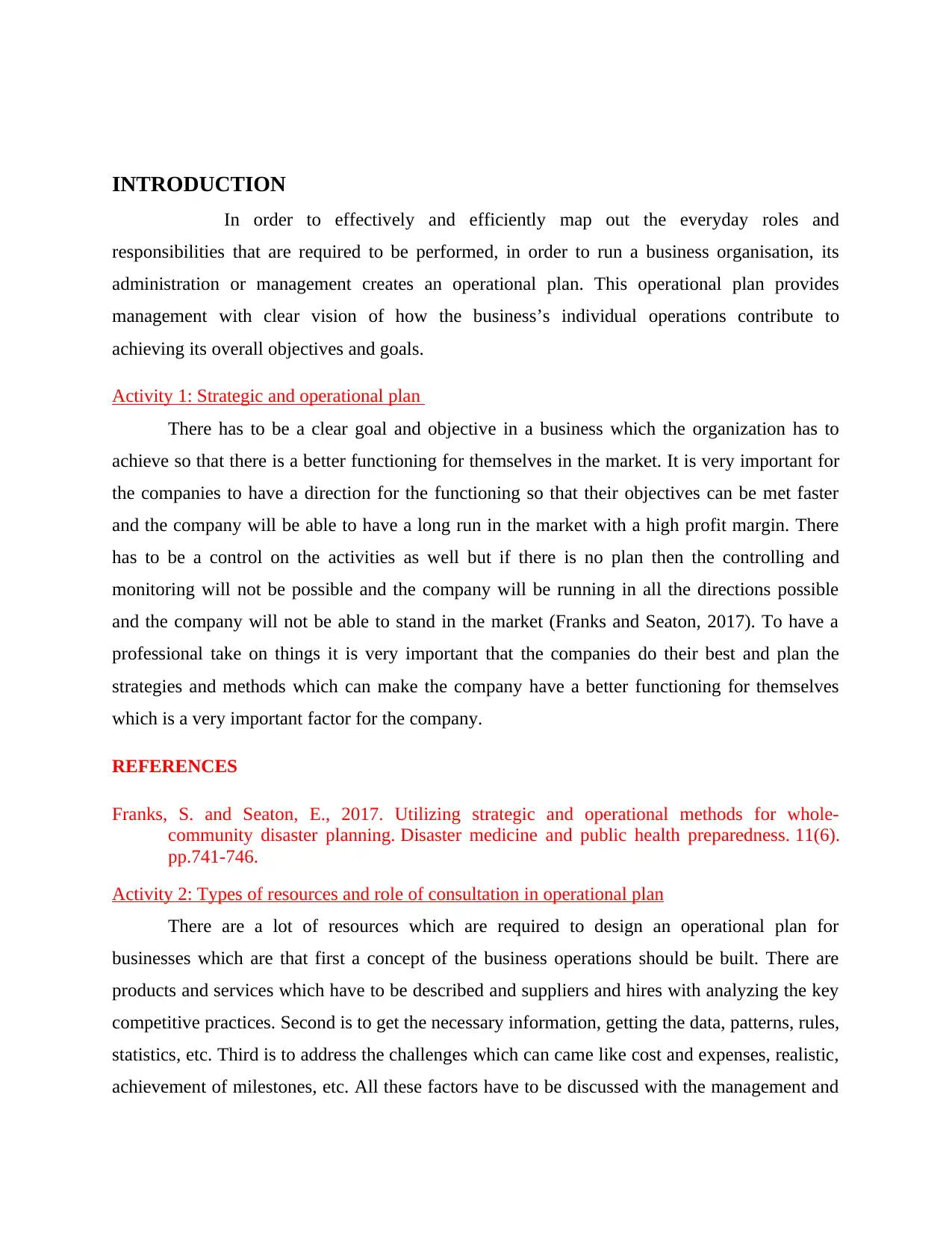
INTRODUCTION
In order to effectively and efficiently map out the everyday roles and
responsibilities that are required to be performed, in order to run a business organisation, its
administration or management creates an operational plan. This operational plan provides
management with clear vision of how the business’s individual operations contribute to
achieving its overall objectives and goals.
Activity 1: Strategic and operational plan
There has to be a clear goal and objective in a business which the organization has to
achieve so that there is a better functioning for themselves in the market. It is very important for
the companies to have a direction for the functioning so that their objectives can be met faster
and the company will be able to have a long run in the market with a high profit margin. There
has to be a control on the activities as well but if there is no plan then the controlling and
monitoring will not be possible and the company will be running in all the directions possible
and the company will not be able to stand in the market (Franks and Seaton, 2017). To have a
professional take on things it is very important that the companies do their best and plan the
strategies and methods which can make the company have a better functioning for themselves
which is a very important factor for the company.
REFERENCES
Franks, S. and Seaton, E., 2017. Utilizing strategic and operational methods for whole-
community disaster planning. Disaster medicine and public health preparedness. 11(6).
pp.741-746.
Activity 2: Types of resources and role of consultation in operational plan
There are a lot of resources which are required to design an operational plan for
businesses which are that first a concept of the business operations should be built. There are
products and services which have to be described and suppliers and hires with analyzing the key
competitive practices. Second is to get the necessary information, getting the data, patterns, rules,
statistics, etc. Third is to address the challenges which can came like cost and expenses, realistic,
achievement of milestones, etc. All these factors have to be discussed with the management and
In order to effectively and efficiently map out the everyday roles and
responsibilities that are required to be performed, in order to run a business organisation, its
administration or management creates an operational plan. This operational plan provides
management with clear vision of how the business’s individual operations contribute to
achieving its overall objectives and goals.
Activity 1: Strategic and operational plan
There has to be a clear goal and objective in a business which the organization has to
achieve so that there is a better functioning for themselves in the market. It is very important for
the companies to have a direction for the functioning so that their objectives can be met faster
and the company will be able to have a long run in the market with a high profit margin. There
has to be a control on the activities as well but if there is no plan then the controlling and
monitoring will not be possible and the company will be running in all the directions possible
and the company will not be able to stand in the market (Franks and Seaton, 2017). To have a
professional take on things it is very important that the companies do their best and plan the
strategies and methods which can make the company have a better functioning for themselves
which is a very important factor for the company.
REFERENCES
Franks, S. and Seaton, E., 2017. Utilizing strategic and operational methods for whole-
community disaster planning. Disaster medicine and public health preparedness. 11(6).
pp.741-746.
Activity 2: Types of resources and role of consultation in operational plan
There are a lot of resources which are required to design an operational plan for
businesses which are that first a concept of the business operations should be built. There are
products and services which have to be described and suppliers and hires with analyzing the key
competitive practices. Second is to get the necessary information, getting the data, patterns, rules,
statistics, etc. Third is to address the challenges which can came like cost and expenses, realistic,
achievement of milestones, etc. All these factors have to be discussed with the management and
⊘ This is a preview!⊘
Do you want full access?
Subscribe today to unlock all pages.

Trusted by 1+ million students worldwide
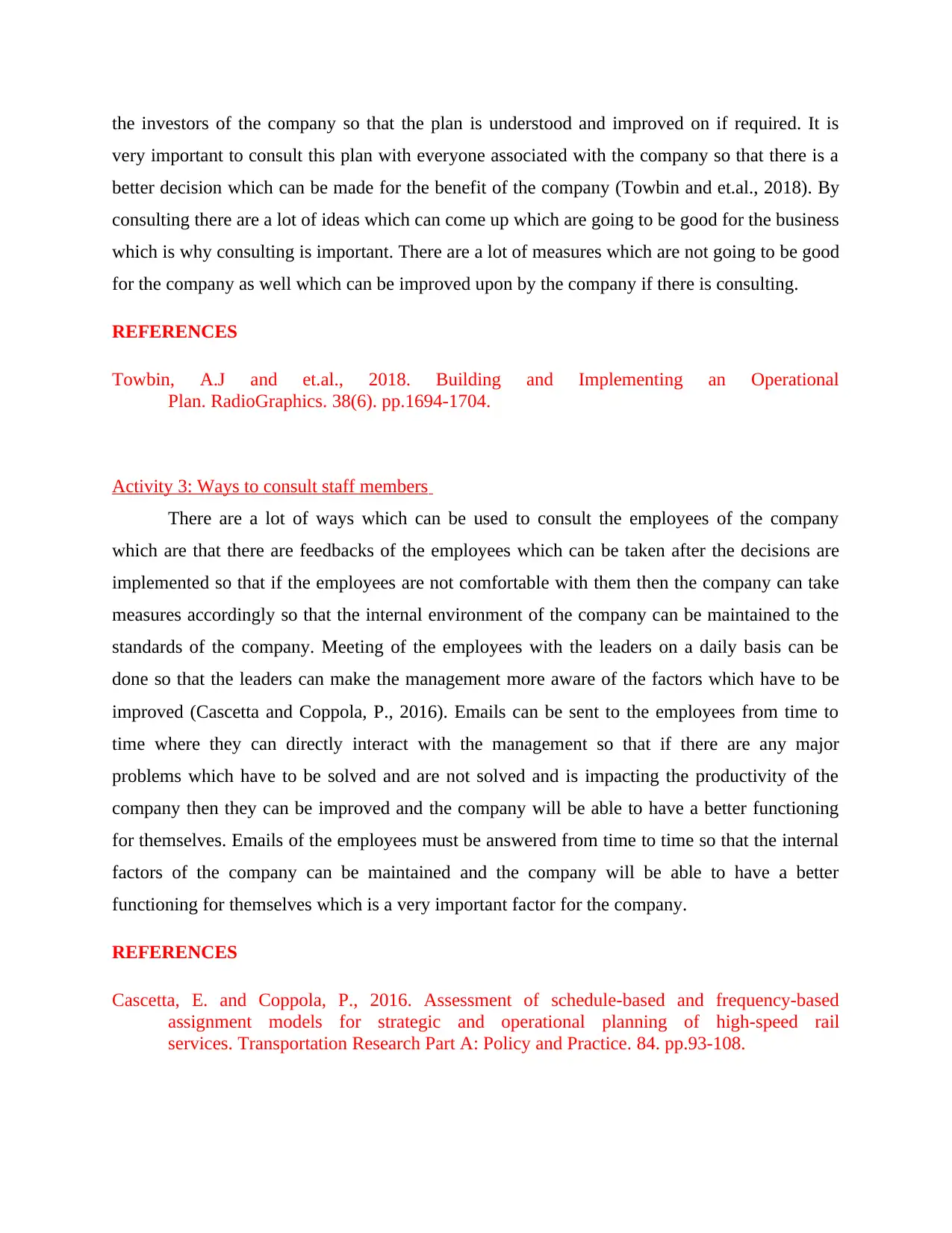
the investors of the company so that the plan is understood and improved on if required. It is
very important to consult this plan with everyone associated with the company so that there is a
better decision which can be made for the benefit of the company (Towbin and et.al., 2018). By
consulting there are a lot of ideas which can come up which are going to be good for the business
which is why consulting is important. There are a lot of measures which are not going to be good
for the company as well which can be improved upon by the company if there is consulting.
REFERENCES
Towbin, A.J and et.al., 2018. Building and Implementing an Operational
Plan. RadioGraphics. 38(6). pp.1694-1704.
Activity 3: Ways to consult staff members
There are a lot of ways which can be used to consult the employees of the company
which are that there are feedbacks of the employees which can be taken after the decisions are
implemented so that if the employees are not comfortable with them then the company can take
measures accordingly so that the internal environment of the company can be maintained to the
standards of the company. Meeting of the employees with the leaders on a daily basis can be
done so that the leaders can make the management more aware of the factors which have to be
improved (Cascetta and Coppola, P., 2016). Emails can be sent to the employees from time to
time where they can directly interact with the management so that if there are any major
problems which have to be solved and are not solved and is impacting the productivity of the
company then they can be improved and the company will be able to have a better functioning
for themselves. Emails of the employees must be answered from time to time so that the internal
factors of the company can be maintained and the company will be able to have a better
functioning for themselves which is a very important factor for the company.
REFERENCES
Cascetta, E. and Coppola, P., 2016. Assessment of schedule-based and frequency-based
assignment models for strategic and operational planning of high-speed rail
services. Transportation Research Part A: Policy and Practice. 84. pp.93-108.
very important to consult this plan with everyone associated with the company so that there is a
better decision which can be made for the benefit of the company (Towbin and et.al., 2018). By
consulting there are a lot of ideas which can come up which are going to be good for the business
which is why consulting is important. There are a lot of measures which are not going to be good
for the company as well which can be improved upon by the company if there is consulting.
REFERENCES
Towbin, A.J and et.al., 2018. Building and Implementing an Operational
Plan. RadioGraphics. 38(6). pp.1694-1704.
Activity 3: Ways to consult staff members
There are a lot of ways which can be used to consult the employees of the company
which are that there are feedbacks of the employees which can be taken after the decisions are
implemented so that if the employees are not comfortable with them then the company can take
measures accordingly so that the internal environment of the company can be maintained to the
standards of the company. Meeting of the employees with the leaders on a daily basis can be
done so that the leaders can make the management more aware of the factors which have to be
improved (Cascetta and Coppola, P., 2016). Emails can be sent to the employees from time to
time where they can directly interact with the management so that if there are any major
problems which have to be solved and are not solved and is impacting the productivity of the
company then they can be improved and the company will be able to have a better functioning
for themselves. Emails of the employees must be answered from time to time so that the internal
factors of the company can be maintained and the company will be able to have a better
functioning for themselves which is a very important factor for the company.
REFERENCES
Cascetta, E. and Coppola, P., 2016. Assessment of schedule-based and frequency-based
assignment models for strategic and operational planning of high-speed rail
services. Transportation Research Part A: Policy and Practice. 84. pp.93-108.
Paraphrase This Document
Need a fresh take? Get an instant paraphrase of this document with our AI Paraphraser
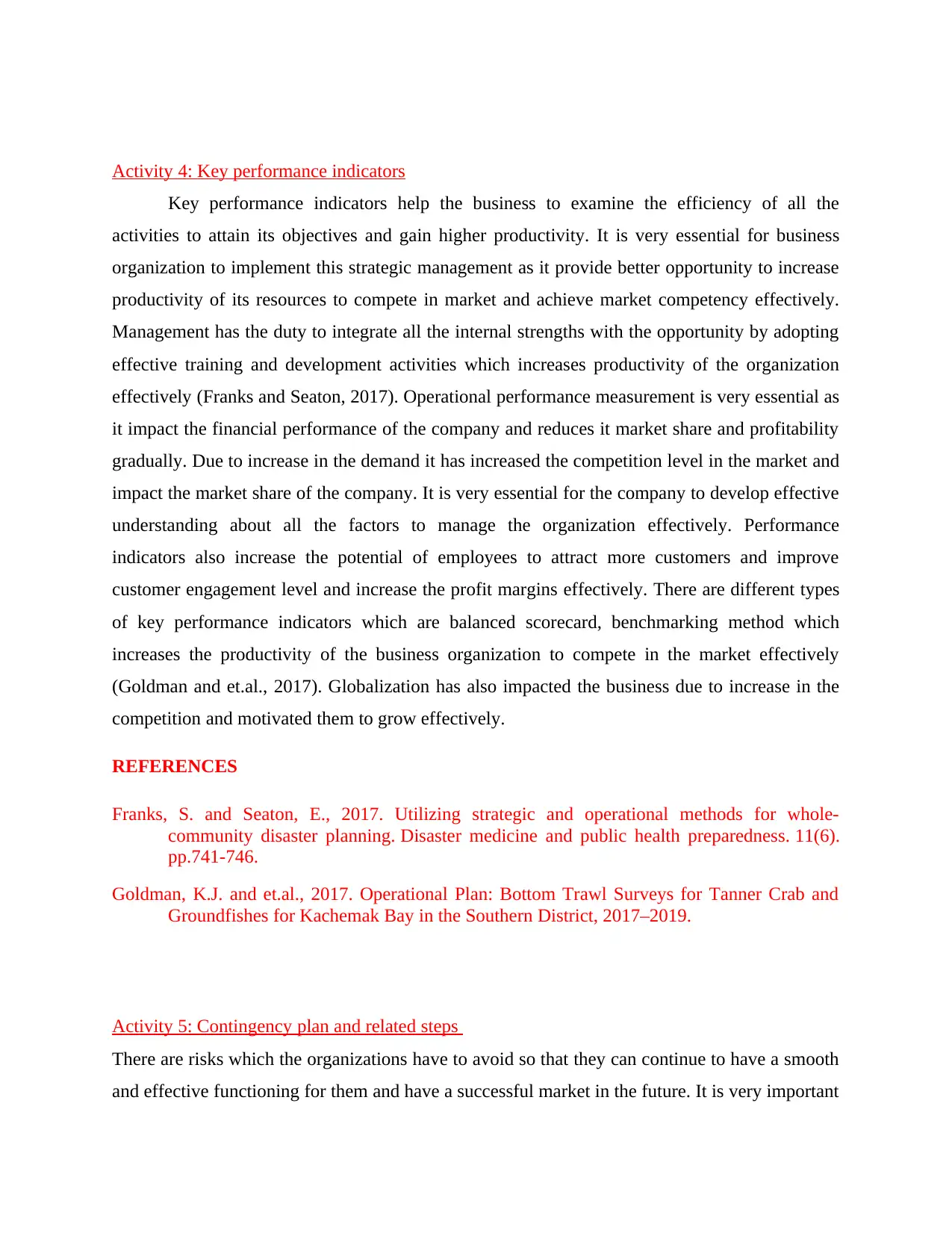
Activity 4: Key performance indicators
Key performance indicators help the business to examine the efficiency of all the
activities to attain its objectives and gain higher productivity. It is very essential for business
organization to implement this strategic management as it provide better opportunity to increase
productivity of its resources to compete in market and achieve market competency effectively.
Management has the duty to integrate all the internal strengths with the opportunity by adopting
effective training and development activities which increases productivity of the organization
effectively (Franks and Seaton, 2017). Operational performance measurement is very essential as
it impact the financial performance of the company and reduces it market share and profitability
gradually. Due to increase in the demand it has increased the competition level in the market and
impact the market share of the company. It is very essential for the company to develop effective
understanding about all the factors to manage the organization effectively. Performance
indicators also increase the potential of employees to attract more customers and improve
customer engagement level and increase the profit margins effectively. There are different types
of key performance indicators which are balanced scorecard, benchmarking method which
increases the productivity of the business organization to compete in the market effectively
(Goldman and et.al., 2017). Globalization has also impacted the business due to increase in the
competition and motivated them to grow effectively.
REFERENCES
Franks, S. and Seaton, E., 2017. Utilizing strategic and operational methods for whole-
community disaster planning. Disaster medicine and public health preparedness. 11(6).
pp.741-746.
Goldman, K.J. and et.al., 2017. Operational Plan: Bottom Trawl Surveys for Tanner Crab and
Groundfishes for Kachemak Bay in the Southern District, 2017–2019.
Activity 5: Contingency plan and related steps
There are risks which the organizations have to avoid so that they can continue to have a smooth
and effective functioning for them and have a successful market in the future. It is very important
Key performance indicators help the business to examine the efficiency of all the
activities to attain its objectives and gain higher productivity. It is very essential for business
organization to implement this strategic management as it provide better opportunity to increase
productivity of its resources to compete in market and achieve market competency effectively.
Management has the duty to integrate all the internal strengths with the opportunity by adopting
effective training and development activities which increases productivity of the organization
effectively (Franks and Seaton, 2017). Operational performance measurement is very essential as
it impact the financial performance of the company and reduces it market share and profitability
gradually. Due to increase in the demand it has increased the competition level in the market and
impact the market share of the company. It is very essential for the company to develop effective
understanding about all the factors to manage the organization effectively. Performance
indicators also increase the potential of employees to attract more customers and improve
customer engagement level and increase the profit margins effectively. There are different types
of key performance indicators which are balanced scorecard, benchmarking method which
increases the productivity of the business organization to compete in the market effectively
(Goldman and et.al., 2017). Globalization has also impacted the business due to increase in the
competition and motivated them to grow effectively.
REFERENCES
Franks, S. and Seaton, E., 2017. Utilizing strategic and operational methods for whole-
community disaster planning. Disaster medicine and public health preparedness. 11(6).
pp.741-746.
Goldman, K.J. and et.al., 2017. Operational Plan: Bottom Trawl Surveys for Tanner Crab and
Groundfishes for Kachemak Bay in the Southern District, 2017–2019.
Activity 5: Contingency plan and related steps
There are risks which the organizations have to avoid so that they can continue to have a smooth
and effective functioning for them and have a successful market in the future. It is very important
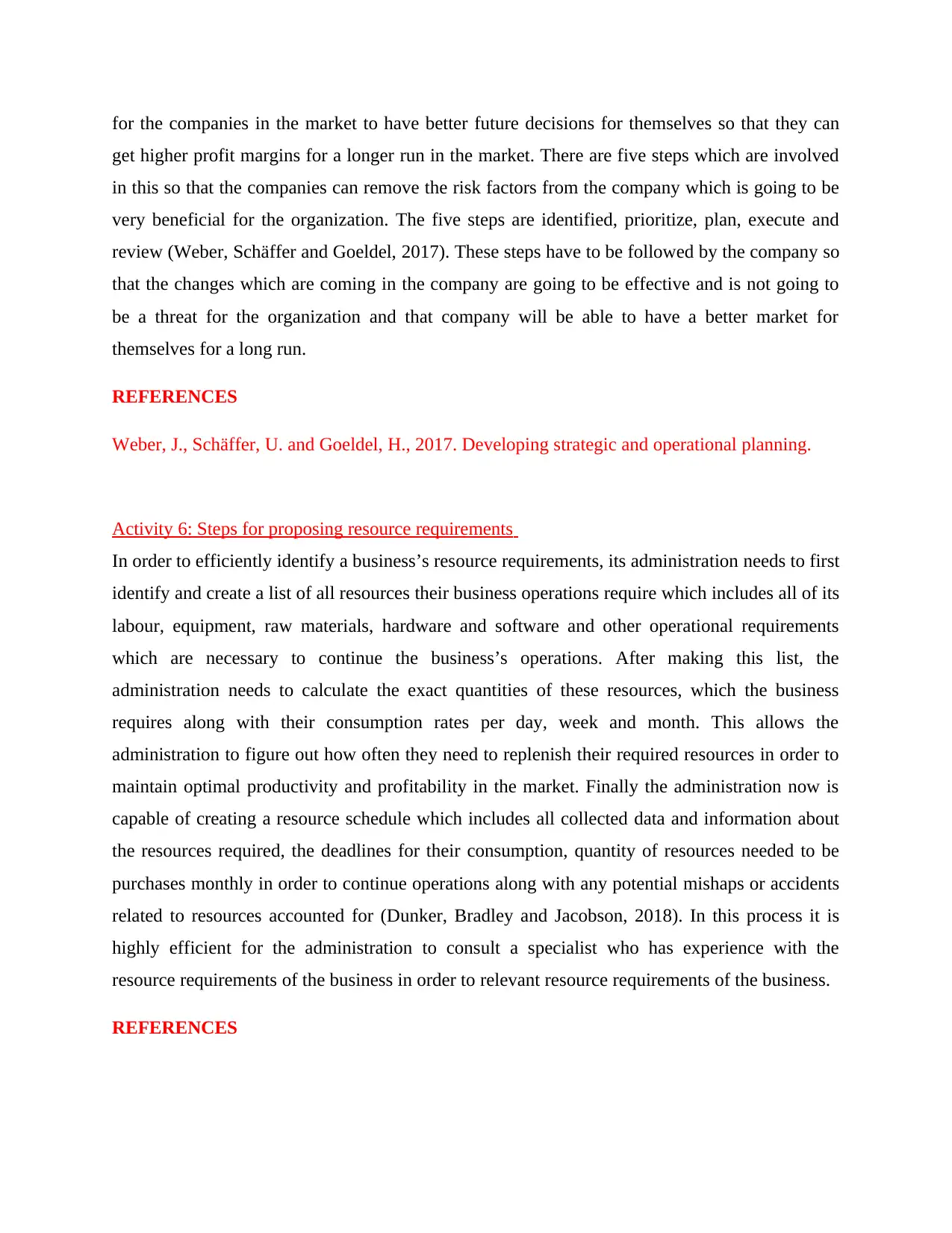
for the companies in the market to have better future decisions for themselves so that they can
get higher profit margins for a longer run in the market. There are five steps which are involved
in this so that the companies can remove the risk factors from the company which is going to be
very beneficial for the organization. The five steps are identified, prioritize, plan, execute and
review (Weber, Schäffer and Goeldel, 2017). These steps have to be followed by the company so
that the changes which are coming in the company are going to be effective and is not going to
be a threat for the organization and that company will be able to have a better market for
themselves for a long run.
REFERENCES
Weber, J., Schäffer, U. and Goeldel, H., 2017. Developing strategic and operational planning.
Activity 6: Steps for proposing resource requirements
In order to efficiently identify a business’s resource requirements, its administration needs to first
identify and create a list of all resources their business operations require which includes all of its
labour, equipment, raw materials, hardware and software and other operational requirements
which are necessary to continue the business’s operations. After making this list, the
administration needs to calculate the exact quantities of these resources, which the business
requires along with their consumption rates per day, week and month. This allows the
administration to figure out how often they need to replenish their required resources in order to
maintain optimal productivity and profitability in the market. Finally the administration now is
capable of creating a resource schedule which includes all collected data and information about
the resources required, the deadlines for their consumption, quantity of resources needed to be
purchases monthly in order to continue operations along with any potential mishaps or accidents
related to resources accounted for (Dunker, Bradley and Jacobson, 2018). In this process it is
highly efficient for the administration to consult a specialist who has experience with the
resource requirements of the business in order to relevant resource requirements of the business.
REFERENCES
get higher profit margins for a longer run in the market. There are five steps which are involved
in this so that the companies can remove the risk factors from the company which is going to be
very beneficial for the organization. The five steps are identified, prioritize, plan, execute and
review (Weber, Schäffer and Goeldel, 2017). These steps have to be followed by the company so
that the changes which are coming in the company are going to be effective and is not going to
be a threat for the organization and that company will be able to have a better market for
themselves for a long run.
REFERENCES
Weber, J., Schäffer, U. and Goeldel, H., 2017. Developing strategic and operational planning.
Activity 6: Steps for proposing resource requirements
In order to efficiently identify a business’s resource requirements, its administration needs to first
identify and create a list of all resources their business operations require which includes all of its
labour, equipment, raw materials, hardware and software and other operational requirements
which are necessary to continue the business’s operations. After making this list, the
administration needs to calculate the exact quantities of these resources, which the business
requires along with their consumption rates per day, week and month. This allows the
administration to figure out how often they need to replenish their required resources in order to
maintain optimal productivity and profitability in the market. Finally the administration now is
capable of creating a resource schedule which includes all collected data and information about
the resources required, the deadlines for their consumption, quantity of resources needed to be
purchases monthly in order to continue operations along with any potential mishaps or accidents
related to resources accounted for (Dunker, Bradley and Jacobson, 2018). In this process it is
highly efficient for the administration to consult a specialist who has experience with the
resource requirements of the business in order to relevant resource requirements of the business.
REFERENCES
⊘ This is a preview!⊘
Do you want full access?
Subscribe today to unlock all pages.

Trusted by 1+ million students worldwide
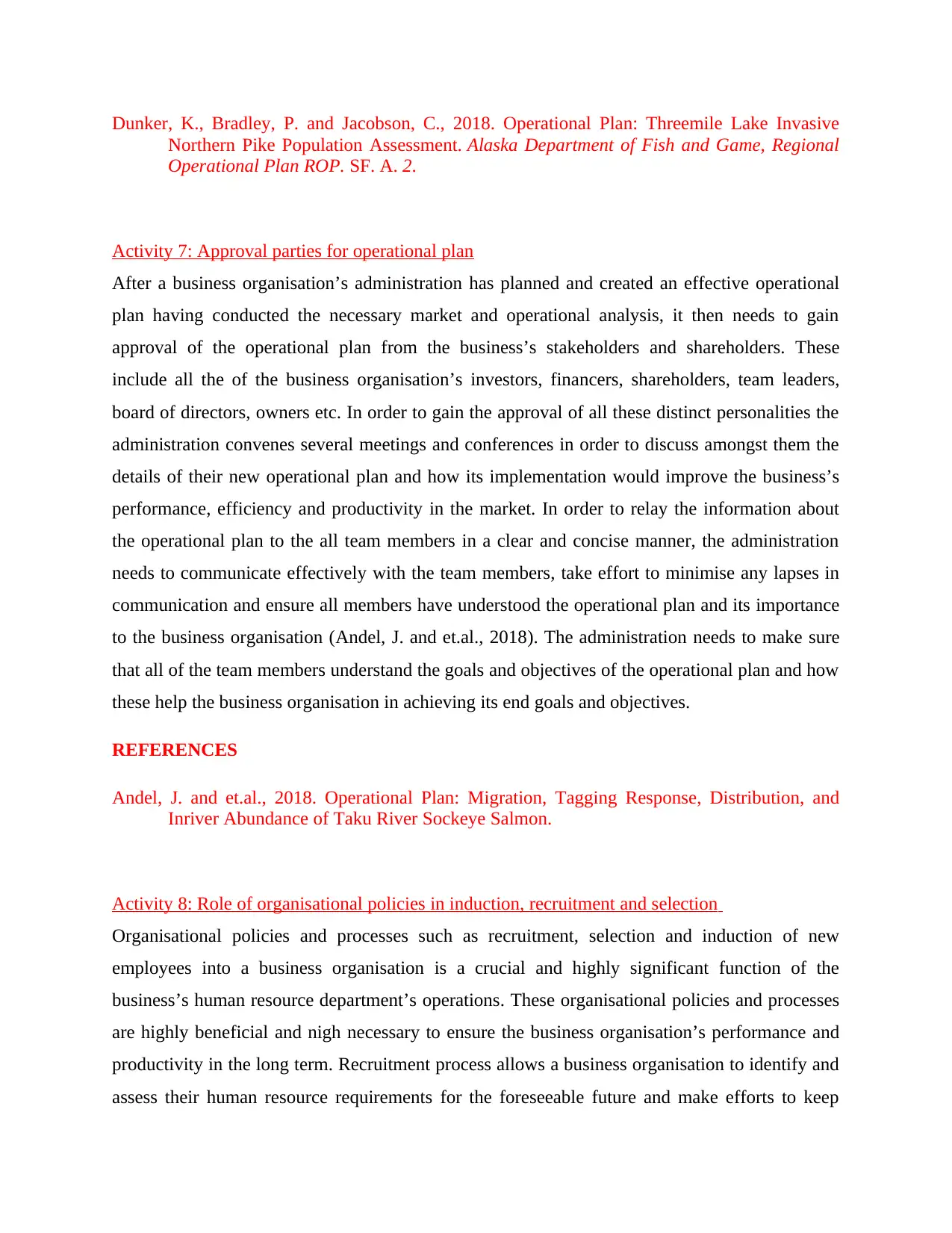
Dunker, K., Bradley, P. and Jacobson, C., 2018. Operational Plan: Threemile Lake Invasive
Northern Pike Population Assessment. Alaska Department of Fish and Game, Regional
Operational Plan ROP. SF. A. 2.
Activity 7: Approval parties for operational plan
After a business organisation’s administration has planned and created an effective operational
plan having conducted the necessary market and operational analysis, it then needs to gain
approval of the operational plan from the business’s stakeholders and shareholders. These
include all the of the business organisation’s investors, financers, shareholders, team leaders,
board of directors, owners etc. In order to gain the approval of all these distinct personalities the
administration convenes several meetings and conferences in order to discuss amongst them the
details of their new operational plan and how its implementation would improve the business’s
performance, efficiency and productivity in the market. In order to relay the information about
the operational plan to the all team members in a clear and concise manner, the administration
needs to communicate effectively with the team members, take effort to minimise any lapses in
communication and ensure all members have understood the operational plan and its importance
to the business organisation (Andel, J. and et.al., 2018). The administration needs to make sure
that all of the team members understand the goals and objectives of the operational plan and how
these help the business organisation in achieving its end goals and objectives.
REFERENCES
Andel, J. and et.al., 2018. Operational Plan: Migration, Tagging Response, Distribution, and
Inriver Abundance of Taku River Sockeye Salmon.
Activity 8: Role of organisational policies in induction, recruitment and selection
Organisational policies and processes such as recruitment, selection and induction of new
employees into a business organisation is a crucial and highly significant function of the
business’s human resource department’s operations. These organisational policies and processes
are highly beneficial and nigh necessary to ensure the business organisation’s performance and
productivity in the long term. Recruitment process allows a business organisation to identify and
assess their human resource requirements for the foreseeable future and make efforts to keep
Northern Pike Population Assessment. Alaska Department of Fish and Game, Regional
Operational Plan ROP. SF. A. 2.
Activity 7: Approval parties for operational plan
After a business organisation’s administration has planned and created an effective operational
plan having conducted the necessary market and operational analysis, it then needs to gain
approval of the operational plan from the business’s stakeholders and shareholders. These
include all the of the business organisation’s investors, financers, shareholders, team leaders,
board of directors, owners etc. In order to gain the approval of all these distinct personalities the
administration convenes several meetings and conferences in order to discuss amongst them the
details of their new operational plan and how its implementation would improve the business’s
performance, efficiency and productivity in the market. In order to relay the information about
the operational plan to the all team members in a clear and concise manner, the administration
needs to communicate effectively with the team members, take effort to minimise any lapses in
communication and ensure all members have understood the operational plan and its importance
to the business organisation (Andel, J. and et.al., 2018). The administration needs to make sure
that all of the team members understand the goals and objectives of the operational plan and how
these help the business organisation in achieving its end goals and objectives.
REFERENCES
Andel, J. and et.al., 2018. Operational Plan: Migration, Tagging Response, Distribution, and
Inriver Abundance of Taku River Sockeye Salmon.
Activity 8: Role of organisational policies in induction, recruitment and selection
Organisational policies and processes such as recruitment, selection and induction of new
employees into a business organisation is a crucial and highly significant function of the
business’s human resource department’s operations. These organisational policies and processes
are highly beneficial and nigh necessary to ensure the business organisation’s performance and
productivity in the long term. Recruitment process allows a business organisation to identify and
assess their human resource requirements for the foreseeable future and make efforts to keep
Paraphrase This Document
Need a fresh take? Get an instant paraphrase of this document with our AI Paraphraser
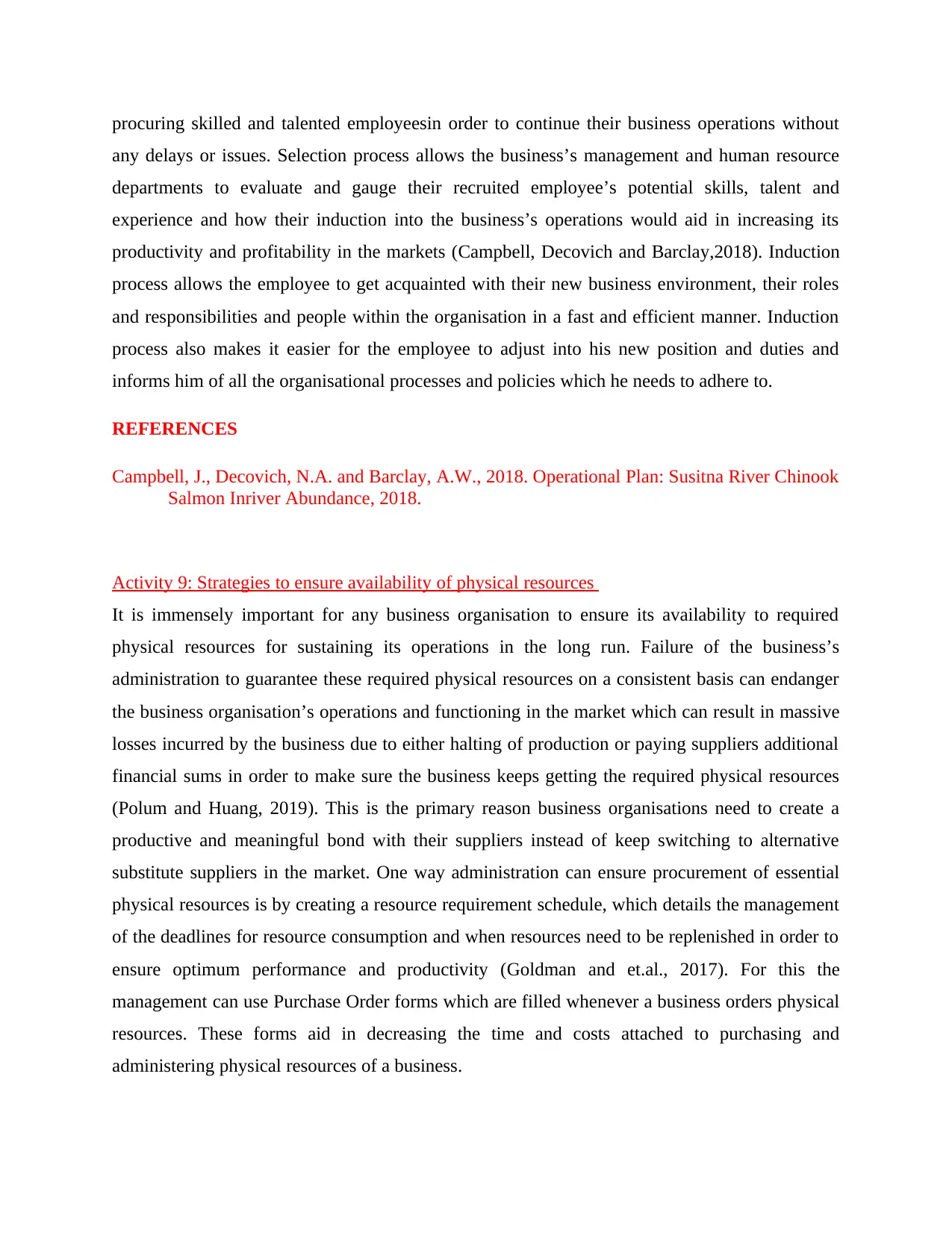
procuring skilled and talented employeesin order to continue their business operations without
any delays or issues. Selection process allows the business’s management and human resource
departments to evaluate and gauge their recruited employee’s potential skills, talent and
experience and how their induction into the business’s operations would aid in increasing its
productivity and profitability in the markets (Campbell, Decovich and Barclay,2018). Induction
process allows the employee to get acquainted with their new business environment, their roles
and responsibilities and people within the organisation in a fast and efficient manner. Induction
process also makes it easier for the employee to adjust into his new position and duties and
informs him of all the organisational processes and policies which he needs to adhere to.
REFERENCES
Campbell, J., Decovich, N.A. and Barclay, A.W., 2018. Operational Plan: Susitna River Chinook
Salmon Inriver Abundance, 2018.
Activity 9: Strategies to ensure availability of physical resources
It is immensely important for any business organisation to ensure its availability to required
physical resources for sustaining its operations in the long run. Failure of the business’s
administration to guarantee these required physical resources on a consistent basis can endanger
the business organisation’s operations and functioning in the market which can result in massive
losses incurred by the business due to either halting of production or paying suppliers additional
financial sums in order to make sure the business keeps getting the required physical resources
(Polum and Huang, 2019). This is the primary reason business organisations need to create a
productive and meaningful bond with their suppliers instead of keep switching to alternative
substitute suppliers in the market. One way administration can ensure procurement of essential
physical resources is by creating a resource requirement schedule, which details the management
of the deadlines for resource consumption and when resources need to be replenished in order to
ensure optimum performance and productivity (Goldman and et.al., 2017). For this the
management can use Purchase Order forms which are filled whenever a business orders physical
resources. These forms aid in decreasing the time and costs attached to purchasing and
administering physical resources of a business.
any delays or issues. Selection process allows the business’s management and human resource
departments to evaluate and gauge their recruited employee’s potential skills, talent and
experience and how their induction into the business’s operations would aid in increasing its
productivity and profitability in the markets (Campbell, Decovich and Barclay,2018). Induction
process allows the employee to get acquainted with their new business environment, their roles
and responsibilities and people within the organisation in a fast and efficient manner. Induction
process also makes it easier for the employee to adjust into his new position and duties and
informs him of all the organisational processes and policies which he needs to adhere to.
REFERENCES
Campbell, J., Decovich, N.A. and Barclay, A.W., 2018. Operational Plan: Susitna River Chinook
Salmon Inriver Abundance, 2018.
Activity 9: Strategies to ensure availability of physical resources
It is immensely important for any business organisation to ensure its availability to required
physical resources for sustaining its operations in the long run. Failure of the business’s
administration to guarantee these required physical resources on a consistent basis can endanger
the business organisation’s operations and functioning in the market which can result in massive
losses incurred by the business due to either halting of production or paying suppliers additional
financial sums in order to make sure the business keeps getting the required physical resources
(Polum and Huang, 2019). This is the primary reason business organisations need to create a
productive and meaningful bond with their suppliers instead of keep switching to alternative
substitute suppliers in the market. One way administration can ensure procurement of essential
physical resources is by creating a resource requirement schedule, which details the management
of the deadlines for resource consumption and when resources need to be replenished in order to
ensure optimum performance and productivity (Goldman and et.al., 2017). For this the
management can use Purchase Order forms which are filled whenever a business orders physical
resources. These forms aid in decreasing the time and costs attached to purchasing and
administering physical resources of a business.
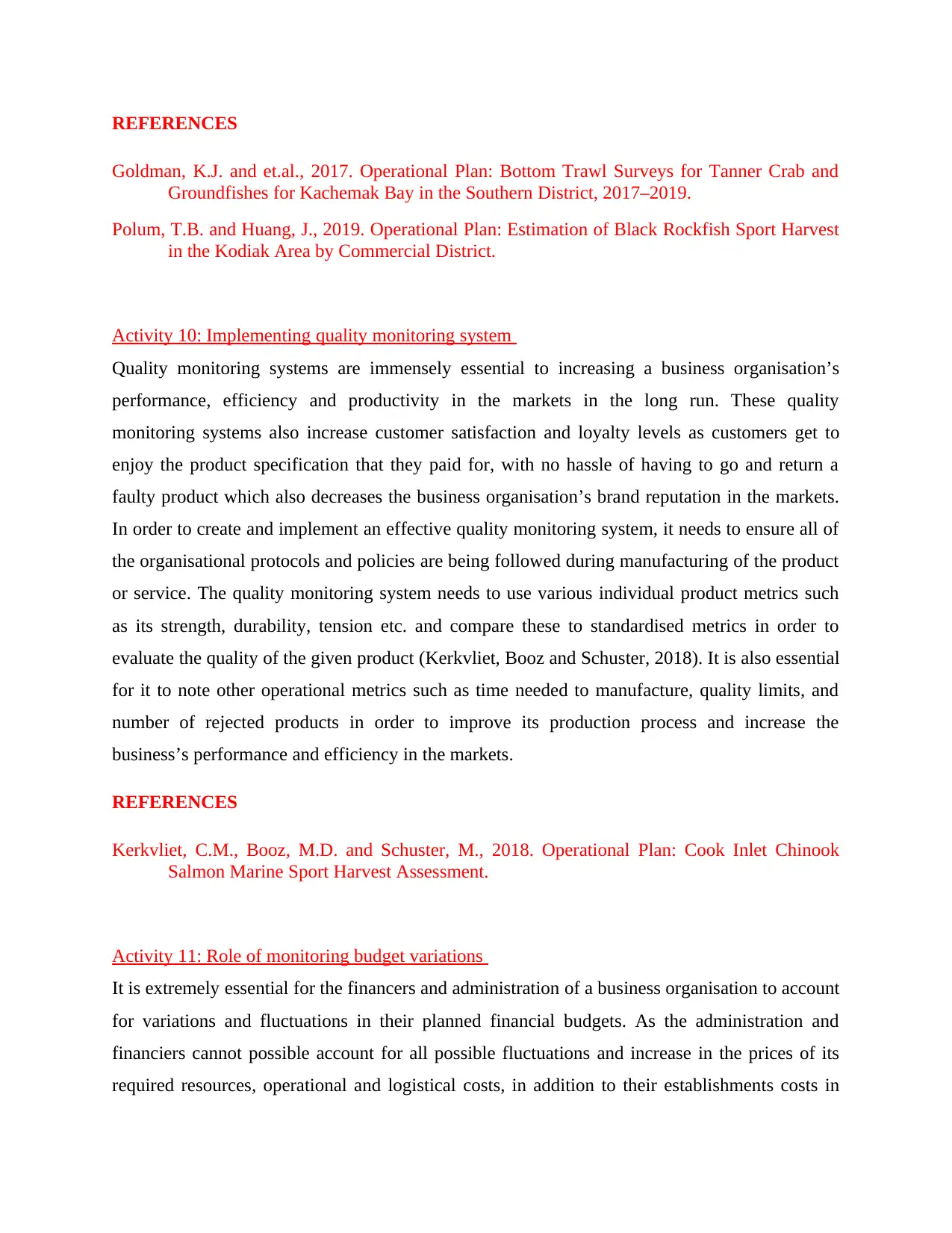
REFERENCES
Goldman, K.J. and et.al., 2017. Operational Plan: Bottom Trawl Surveys for Tanner Crab and
Groundfishes for Kachemak Bay in the Southern District, 2017–2019.
Polum, T.B. and Huang, J., 2019. Operational Plan: Estimation of Black Rockfish Sport Harvest
in the Kodiak Area by Commercial District.
Activity 10: Implementing quality monitoring system
Quality monitoring systems are immensely essential to increasing a business organisation’s
performance, efficiency and productivity in the markets in the long run. These quality
monitoring systems also increase customer satisfaction and loyalty levels as customers get to
enjoy the product specification that they paid for, with no hassle of having to go and return a
faulty product which also decreases the business organisation’s brand reputation in the markets.
In order to create and implement an effective quality monitoring system, it needs to ensure all of
the organisational protocols and policies are being followed during manufacturing of the product
or service. The quality monitoring system needs to use various individual product metrics such
as its strength, durability, tension etc. and compare these to standardised metrics in order to
evaluate the quality of the given product (Kerkvliet, Booz and Schuster, 2018). It is also essential
for it to note other operational metrics such as time needed to manufacture, quality limits, and
number of rejected products in order to improve its production process and increase the
business’s performance and efficiency in the markets.
REFERENCES
Kerkvliet, C.M., Booz, M.D. and Schuster, M., 2018. Operational Plan: Cook Inlet Chinook
Salmon Marine Sport Harvest Assessment.
Activity 11: Role of monitoring budget variations
It is extremely essential for the financers and administration of a business organisation to account
for variations and fluctuations in their planned financial budgets. As the administration and
financiers cannot possible account for all possible fluctuations and increase in the prices of its
required resources, operational and logistical costs, in addition to their establishments costs in
Goldman, K.J. and et.al., 2017. Operational Plan: Bottom Trawl Surveys for Tanner Crab and
Groundfishes for Kachemak Bay in the Southern District, 2017–2019.
Polum, T.B. and Huang, J., 2019. Operational Plan: Estimation of Black Rockfish Sport Harvest
in the Kodiak Area by Commercial District.
Activity 10: Implementing quality monitoring system
Quality monitoring systems are immensely essential to increasing a business organisation’s
performance, efficiency and productivity in the markets in the long run. These quality
monitoring systems also increase customer satisfaction and loyalty levels as customers get to
enjoy the product specification that they paid for, with no hassle of having to go and return a
faulty product which also decreases the business organisation’s brand reputation in the markets.
In order to create and implement an effective quality monitoring system, it needs to ensure all of
the organisational protocols and policies are being followed during manufacturing of the product
or service. The quality monitoring system needs to use various individual product metrics such
as its strength, durability, tension etc. and compare these to standardised metrics in order to
evaluate the quality of the given product (Kerkvliet, Booz and Schuster, 2018). It is also essential
for it to note other operational metrics such as time needed to manufacture, quality limits, and
number of rejected products in order to improve its production process and increase the
business’s performance and efficiency in the markets.
REFERENCES
Kerkvliet, C.M., Booz, M.D. and Schuster, M., 2018. Operational Plan: Cook Inlet Chinook
Salmon Marine Sport Harvest Assessment.
Activity 11: Role of monitoring budget variations
It is extremely essential for the financers and administration of a business organisation to account
for variations and fluctuations in their planned financial budgets. As the administration and
financiers cannot possible account for all possible fluctuations and increase in the prices of its
required resources, operational and logistical costs, in addition to their establishments costs in
⊘ This is a preview!⊘
Do you want full access?
Subscribe today to unlock all pages.

Trusted by 1+ million students worldwide
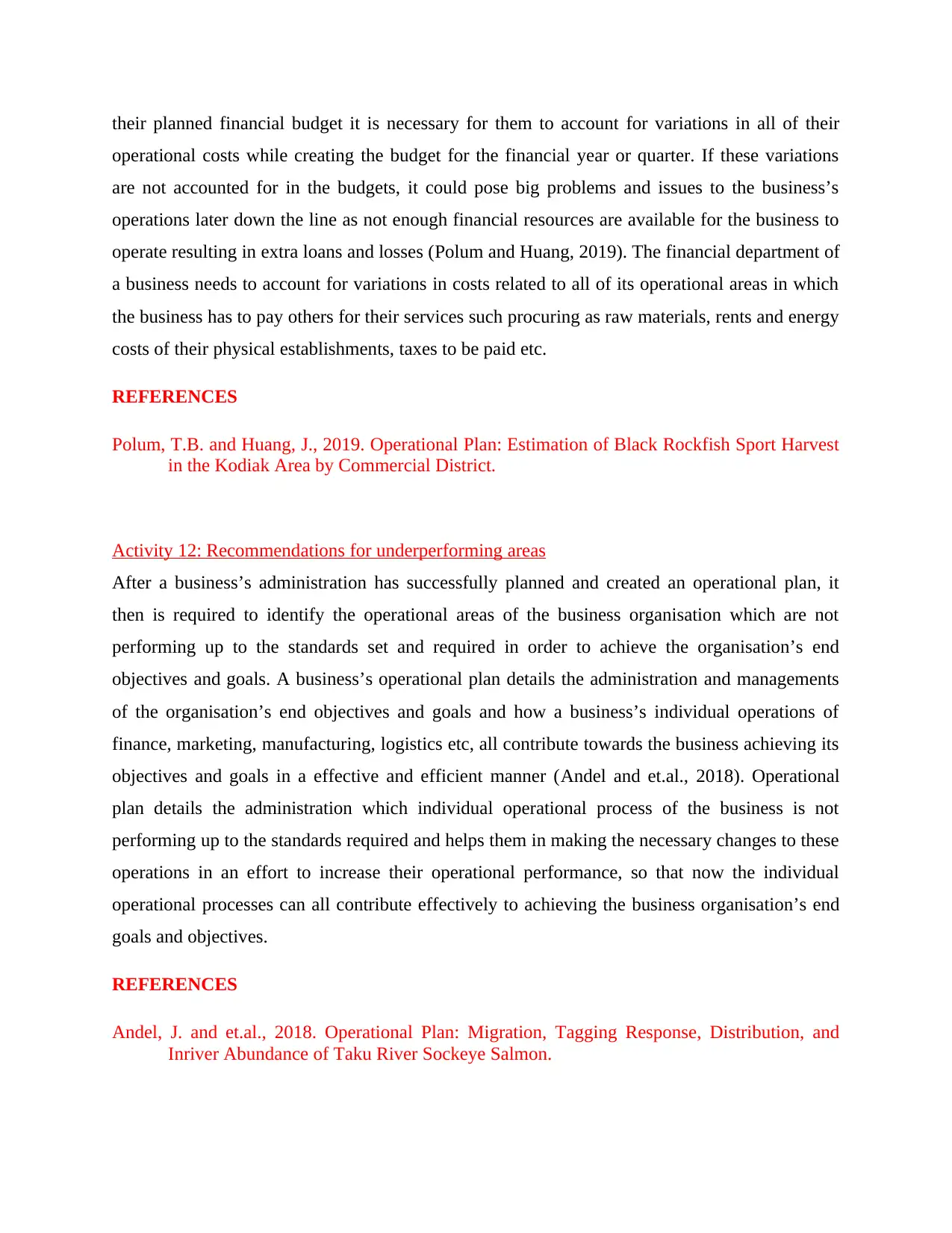
their planned financial budget it is necessary for them to account for variations in all of their
operational costs while creating the budget for the financial year or quarter. If these variations
are not accounted for in the budgets, it could pose big problems and issues to the business’s
operations later down the line as not enough financial resources are available for the business to
operate resulting in extra loans and losses (Polum and Huang, 2019). The financial department of
a business needs to account for variations in costs related to all of its operational areas in which
the business has to pay others for their services such procuring as raw materials, rents and energy
costs of their physical establishments, taxes to be paid etc.
REFERENCES
Polum, T.B. and Huang, J., 2019. Operational Plan: Estimation of Black Rockfish Sport Harvest
in the Kodiak Area by Commercial District.
Activity 12: Recommendations for underperforming areas
After a business’s administration has successfully planned and created an operational plan, it
then is required to identify the operational areas of the business organisation which are not
performing up to the standards set and required in order to achieve the organisation’s end
objectives and goals. A business’s operational plan details the administration and managements
of the organisation’s end objectives and goals and how a business’s individual operations of
finance, marketing, manufacturing, logistics etc, all contribute towards the business achieving its
objectives and goals in a effective and efficient manner (Andel and et.al., 2018). Operational
plan details the administration which individual operational process of the business is not
performing up to the standards required and helps them in making the necessary changes to these
operations in an effort to increase their operational performance, so that now the individual
operational processes can all contribute effectively to achieving the business organisation’s end
goals and objectives.
REFERENCES
Andel, J. and et.al., 2018. Operational Plan: Migration, Tagging Response, Distribution, and
Inriver Abundance of Taku River Sockeye Salmon.
operational costs while creating the budget for the financial year or quarter. If these variations
are not accounted for in the budgets, it could pose big problems and issues to the business’s
operations later down the line as not enough financial resources are available for the business to
operate resulting in extra loans and losses (Polum and Huang, 2019). The financial department of
a business needs to account for variations in costs related to all of its operational areas in which
the business has to pay others for their services such procuring as raw materials, rents and energy
costs of their physical establishments, taxes to be paid etc.
REFERENCES
Polum, T.B. and Huang, J., 2019. Operational Plan: Estimation of Black Rockfish Sport Harvest
in the Kodiak Area by Commercial District.
Activity 12: Recommendations for underperforming areas
After a business’s administration has successfully planned and created an operational plan, it
then is required to identify the operational areas of the business organisation which are not
performing up to the standards set and required in order to achieve the organisation’s end
objectives and goals. A business’s operational plan details the administration and managements
of the organisation’s end objectives and goals and how a business’s individual operations of
finance, marketing, manufacturing, logistics etc, all contribute towards the business achieving its
objectives and goals in a effective and efficient manner (Andel and et.al., 2018). Operational
plan details the administration which individual operational process of the business is not
performing up to the standards required and helps them in making the necessary changes to these
operations in an effort to increase their operational performance, so that now the individual
operational processes can all contribute effectively to achieving the business organisation’s end
goals and objectives.
REFERENCES
Andel, J. and et.al., 2018. Operational Plan: Migration, Tagging Response, Distribution, and
Inriver Abundance of Taku River Sockeye Salmon.
Paraphrase This Document
Need a fresh take? Get an instant paraphrase of this document with our AI Paraphraser
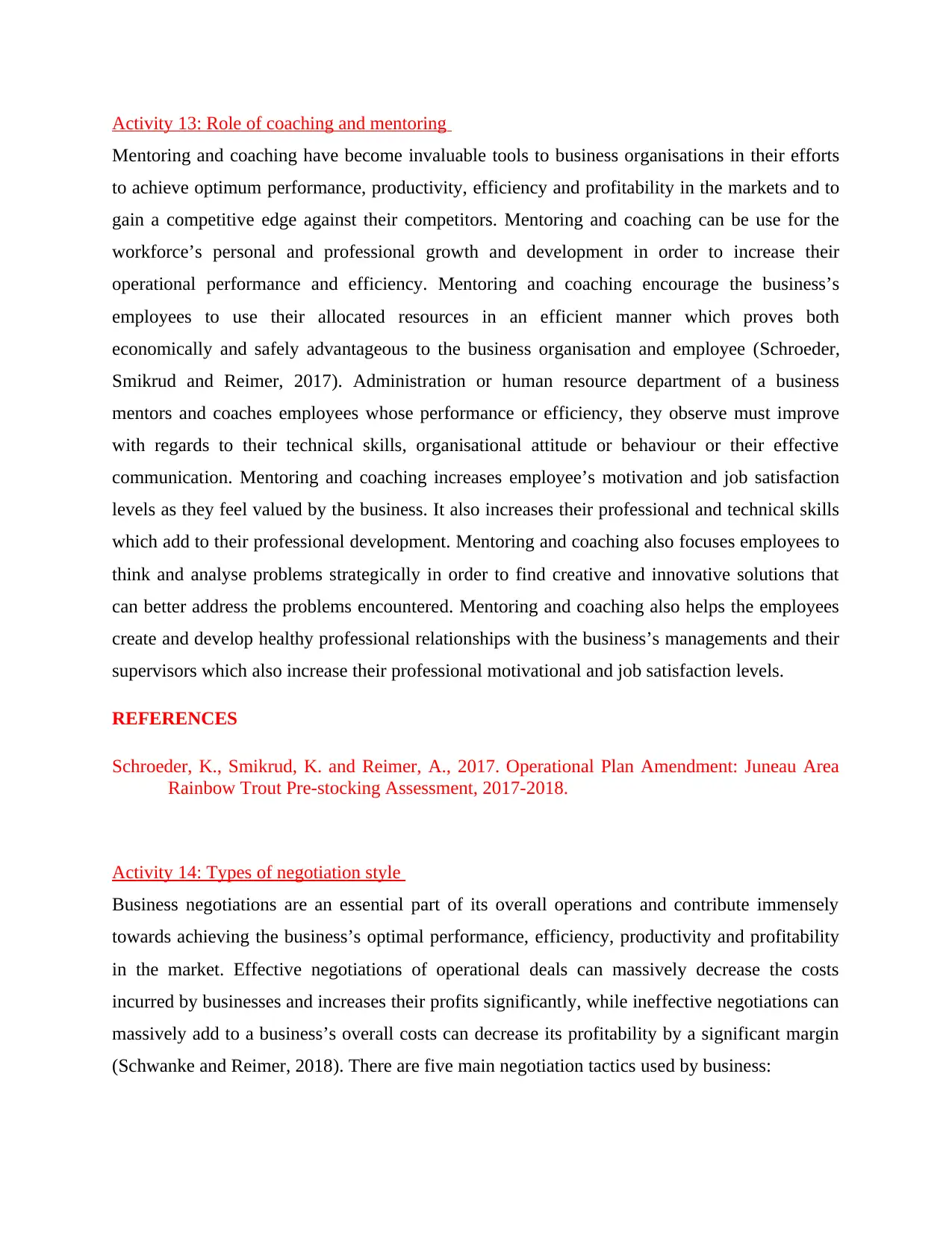
Activity 13: Role of coaching and mentoring
Mentoring and coaching have become invaluable tools to business organisations in their efforts
to achieve optimum performance, productivity, efficiency and profitability in the markets and to
gain a competitive edge against their competitors. Mentoring and coaching can be use for the
workforce’s personal and professional growth and development in order to increase their
operational performance and efficiency. Mentoring and coaching encourage the business’s
employees to use their allocated resources in an efficient manner which proves both
economically and safely advantageous to the business organisation and employee (Schroeder,
Smikrud and Reimer, 2017). Administration or human resource department of a business
mentors and coaches employees whose performance or efficiency, they observe must improve
with regards to their technical skills, organisational attitude or behaviour or their effective
communication. Mentoring and coaching increases employee’s motivation and job satisfaction
levels as they feel valued by the business. It also increases their professional and technical skills
which add to their professional development. Mentoring and coaching also focuses employees to
think and analyse problems strategically in order to find creative and innovative solutions that
can better address the problems encountered. Mentoring and coaching also helps the employees
create and develop healthy professional relationships with the business’s managements and their
supervisors which also increase their professional motivational and job satisfaction levels.
REFERENCES
Schroeder, K., Smikrud, K. and Reimer, A., 2017. Operational Plan Amendment: Juneau Area
Rainbow Trout Pre-stocking Assessment, 2017-2018.
Activity 14: Types of negotiation style
Business negotiations are an essential part of its overall operations and contribute immensely
towards achieving the business’s optimal performance, efficiency, productivity and profitability
in the market. Effective negotiations of operational deals can massively decrease the costs
incurred by businesses and increases their profits significantly, while ineffective negotiations can
massively add to a business’s overall costs can decrease its profitability by a significant margin
(Schwanke and Reimer, 2018). There are five main negotiation tactics used by business:
Mentoring and coaching have become invaluable tools to business organisations in their efforts
to achieve optimum performance, productivity, efficiency and profitability in the markets and to
gain a competitive edge against their competitors. Mentoring and coaching can be use for the
workforce’s personal and professional growth and development in order to increase their
operational performance and efficiency. Mentoring and coaching encourage the business’s
employees to use their allocated resources in an efficient manner which proves both
economically and safely advantageous to the business organisation and employee (Schroeder,
Smikrud and Reimer, 2017). Administration or human resource department of a business
mentors and coaches employees whose performance or efficiency, they observe must improve
with regards to their technical skills, organisational attitude or behaviour or their effective
communication. Mentoring and coaching increases employee’s motivation and job satisfaction
levels as they feel valued by the business. It also increases their professional and technical skills
which add to their professional development. Mentoring and coaching also focuses employees to
think and analyse problems strategically in order to find creative and innovative solutions that
can better address the problems encountered. Mentoring and coaching also helps the employees
create and develop healthy professional relationships with the business’s managements and their
supervisors which also increase their professional motivational and job satisfaction levels.
REFERENCES
Schroeder, K., Smikrud, K. and Reimer, A., 2017. Operational Plan Amendment: Juneau Area
Rainbow Trout Pre-stocking Assessment, 2017-2018.
Activity 14: Types of negotiation style
Business negotiations are an essential part of its overall operations and contribute immensely
towards achieving the business’s optimal performance, efficiency, productivity and profitability
in the market. Effective negotiations of operational deals can massively decrease the costs
incurred by businesses and increases their profits significantly, while ineffective negotiations can
massively add to a business’s overall costs can decrease its profitability by a significant margin
(Schwanke and Reimer, 2018). There are five main negotiation tactics used by business:
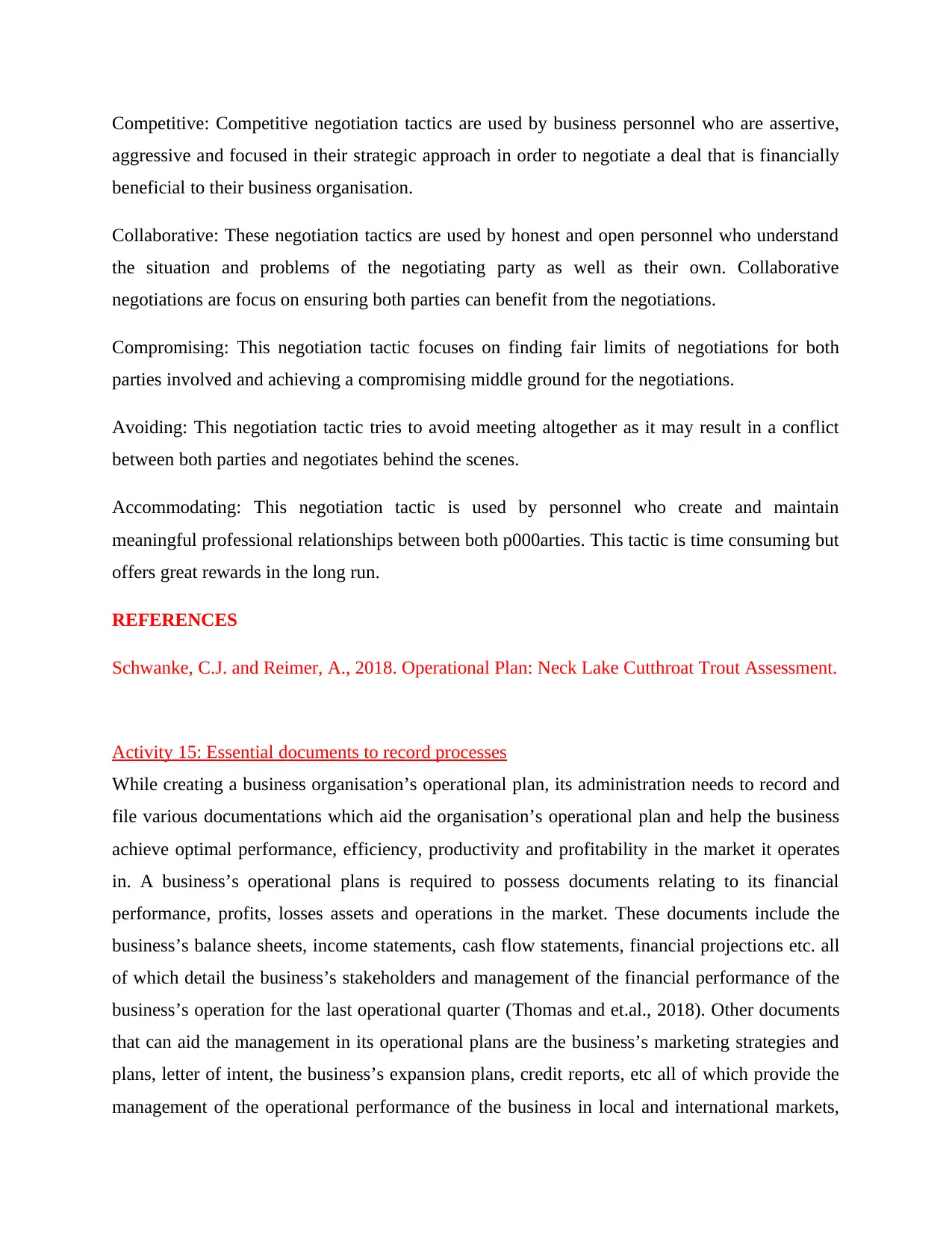
Competitive: Competitive negotiation tactics are used by business personnel who are assertive,
aggressive and focused in their strategic approach in order to negotiate a deal that is financially
beneficial to their business organisation.
Collaborative: These negotiation tactics are used by honest and open personnel who understand
the situation and problems of the negotiating party as well as their own. Collaborative
negotiations are focus on ensuring both parties can benefit from the negotiations.
Compromising: This negotiation tactic focuses on finding fair limits of negotiations for both
parties involved and achieving a compromising middle ground for the negotiations.
Avoiding: This negotiation tactic tries to avoid meeting altogether as it may result in a conflict
between both parties and negotiates behind the scenes.
Accommodating: This negotiation tactic is used by personnel who create and maintain
meaningful professional relationships between both p000arties. This tactic is time consuming but
offers great rewards in the long run.
REFERENCES
Schwanke, C.J. and Reimer, A., 2018. Operational Plan: Neck Lake Cutthroat Trout Assessment.
Activity 15: Essential documents to record processes
While creating a business organisation’s operational plan, its administration needs to record and
file various documentations which aid the organisation’s operational plan and help the business
achieve optimal performance, efficiency, productivity and profitability in the market it operates
in. A business’s operational plans is required to possess documents relating to its financial
performance, profits, losses assets and operations in the market. These documents include the
business’s balance sheets, income statements, cash flow statements, financial projections etc. all
of which detail the business’s stakeholders and management of the financial performance of the
business’s operation for the last operational quarter (Thomas and et.al., 2018). Other documents
that can aid the management in its operational plans are the business’s marketing strategies and
plans, letter of intent, the business’s expansion plans, credit reports, etc all of which provide the
management of the operational performance of the business in local and international markets,
aggressive and focused in their strategic approach in order to negotiate a deal that is financially
beneficial to their business organisation.
Collaborative: These negotiation tactics are used by honest and open personnel who understand
the situation and problems of the negotiating party as well as their own. Collaborative
negotiations are focus on ensuring both parties can benefit from the negotiations.
Compromising: This negotiation tactic focuses on finding fair limits of negotiations for both
parties involved and achieving a compromising middle ground for the negotiations.
Avoiding: This negotiation tactic tries to avoid meeting altogether as it may result in a conflict
between both parties and negotiates behind the scenes.
Accommodating: This negotiation tactic is used by personnel who create and maintain
meaningful professional relationships between both p000arties. This tactic is time consuming but
offers great rewards in the long run.
REFERENCES
Schwanke, C.J. and Reimer, A., 2018. Operational Plan: Neck Lake Cutthroat Trout Assessment.
Activity 15: Essential documents to record processes
While creating a business organisation’s operational plan, its administration needs to record and
file various documentations which aid the organisation’s operational plan and help the business
achieve optimal performance, efficiency, productivity and profitability in the market it operates
in. A business’s operational plans is required to possess documents relating to its financial
performance, profits, losses assets and operations in the market. These documents include the
business’s balance sheets, income statements, cash flow statements, financial projections etc. all
of which detail the business’s stakeholders and management of the financial performance of the
business’s operation for the last operational quarter (Thomas and et.al., 2018). Other documents
that can aid the management in its operational plans are the business’s marketing strategies and
plans, letter of intent, the business’s expansion plans, credit reports, etc all of which provide the
management of the operational performance of the business in local and international markets,
⊘ This is a preview!⊘
Do you want full access?
Subscribe today to unlock all pages.

Trusted by 1+ million students worldwide
1 out of 13
Related Documents
Your All-in-One AI-Powered Toolkit for Academic Success.
+13062052269
info@desklib.com
Available 24*7 on WhatsApp / Email
![[object Object]](/_next/static/media/star-bottom.7253800d.svg)
Unlock your academic potential
Copyright © 2020–2025 A2Z Services. All Rights Reserved. Developed and managed by ZUCOL.





